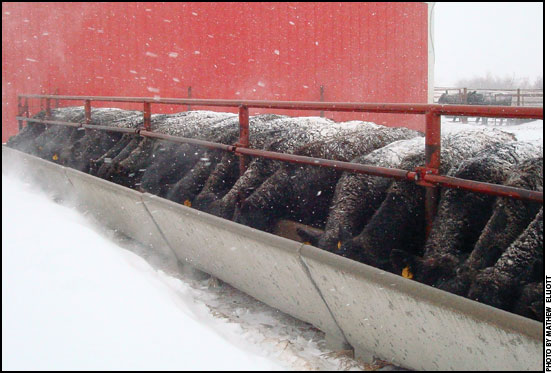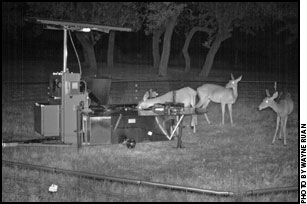HEALTH & NUTRITION...

Arctic Cold Dangerous for Livestock
As Kentucky prepared for an early season arctic blast in early December, with highs expected in the 20s, University of Kentucky (UK) Beef Specialist Jeff Lehmkuhler offered some advice for stockmen.
These temperatures combined with the gusty winds for an extended period can cause cold stress in the “danger” and “emergency” categories, causing problems ranging from frozen waterers to sick cattle. Livestock producers should take precautions and try to understand how these conditions could affect their animals. Read more.
Cow Nutrition Affects Newborn Calf Survival
Protein levels play a vital role.
Russ Daly, Extension veterinarian at South Dakota State University, says cold stress in calves may be aggravated by nutritional issues in the cows. If the cow is in poor condition or doesn't have adequate protein and energy during late gestation, the newborn calf has decreased amounts of brown fat for energy reserves and chills more quickly. Read more.
USDA Scientists Discover How FMD Virus Begins Infection in Cattle
U.S. Department of Agriculture (USDA) scientists have identified the primary site where the virus that causes foot-and-mouth disease (FMD) begins infection in cattle. This discovery could lead to development of new vaccines to control and potentially eradicate FMD, a highly contagious and sometimes fatal viral disease of cloven-hoofed animals that is considered the most economically devastating livestock disease in the world. Read more.

Rick Rasby
Ridin’ Herd
Probe it now.
If you haven't yet tested your forages for the winter feeding program, do it now. Quality can vary a bunch. Forages are the primary energy source for beef cows. Hopefully, up until now, most cows have been grazing crop residue or stockpiled forage. As far as harvested forages are concerned, as forages mature digestibility decreases because of the increase in fiber. When designing diets using harvested feeds, many rations are balanced using average values, and these "book values" often result in over- or underfeeding certain nutrients. More-economical and better-balanced rations can be formulated using nutrient concentrations determined from feed analysis.
Forage testing laboratories will not accept a "grab" sample of a baled forage. Sample baled hay using a forage probe. Most Extension offices will have a forage probe. If they don't, they will know where you can find one. A forage probe is essential for collecting a representative sample. Read more.
Needle-Free Injection In Beef Cattle Examined
Researchers with the University of Manitoba are preparing a study to compare the effectiveness of vaccines administered to beef cattle using conventional needles and syringes to those administered using needle-free injection.
Researchers with the National Centre for Livestock and the Environment (NCLE) expect to begin a one-year study this coming spring to examine the effectiveness of needle-free injection.
Kim Ominski, an associate professor with the University of Manitoba's Faculty of Agricultural and Food Sciences and a researcher with NCLE, says scientists will examine the ability of the animal, as a consequence of the method of delivering the vaccine, to mount an immune response. Read more.
Ridding the Texas-Mexico Border of Cattle Fever Ticks
Reemergence of disease-carrying ticks could cause devastating monetary losses for U.S. beef and dairy producers.

This is an infrared image of a doe in position to be collared at night.
Bovine babesiosis, commonly known as "Texas cattle fever," is a deadly disease of cattle caused by single-celled organisms that are transmitted by cattle fever ticks. Texas cattle fever greatly harmed the cattle industry in the United States until the beginning of the 20th century.
Thanks to highly effective and collaborative control efforts established through the Cattle Fever Tick Eradication Program (CFTEP) in 1906 between producers and state and federal agencies, cattle fever ticks were largely eradicated from this country by 1943. As a result, the United States became free of Texas cattle fever, but cattle fever ticks still thrive in Mexico. CFTEP established a permanent quarantine or "buffer" zone along the Texas-Mexico border to keep the ticks out of the United States. But these potentially disease-carrying ticks — Rhipicephalus (Boophilus) microplus and R. annulatus — are now reinfesting Texas outside of the quarantine zone, thus increasing the risk of outbreaks of Texas cattle fever. Its reemergence could cause devastating monetary losses for U.S. beef and dairy producers. Read more.
Drought Leaves Beef Producers in Need of Forage Supplements
Forages are in short supply in some parts of Indiana and of low quality in others, leaving beef producers to deal with the high prices of alternative feeds to meet the energy and protein needs of their herds, said Ron Lemenager, Purdue Extension beef specialist. Read more.
Cattle Diseases: Common Conditions/Terms
Click here for a list of common conditions and terms related to beef cattle diseases, such as anaplasmosis, brucellosis, BVD, E. coli, IBR and others.
[Click here to go to the top of the page.]





